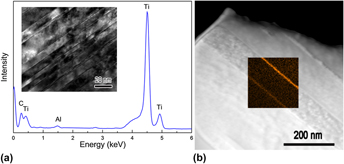Crossref Citations
This article has been cited by the following publications. This list is generated based on data provided by
Crossref.
Wang, Chenxu
Yang, Tengfei
Xiao, Jingren
Liu, Shaoshuai
Xue, Jianming
Wang, Jingyang
Huang, Qing
and
Wang, Yugang
2015.
Irradiation-induced structural transitions in Ti 2 AlC.
Acta Materialia,
Vol. 98,
Issue. ,
p.
197.
Zhang, Hui
Qin, Yifa
Hu, Tao
Wang, Xiaohui
Zhou, Yanchun
and
Rainforth, M.
2015.
On the Faceted and Inclined Twin Boundary of Titanium Carbide Derived from Nanolaminated Ti3AlC2.
Journal of the American Ceramic Society,
Vol. 98,
Issue. 5,
p.
1664.
Shi, Zhiwu
Wei, Hua
Zhang, Hongyu
Jin, Tao
Sun, Xiaofeng
and
Zheng, Qi
2016.
Nanotwinned Ti(O,C) induced by oriented attachment in a hot-pressed Nb–Ti–Al alloy.
Acta Materialia,
Vol. 105,
Issue. ,
p.
114.
Yang, Tengfei
Wang, Chenxu
Liu, Wulong
Liu, Shaoshuai
Xiao, Jingren
Huang, Qing
Xue, Jianming
Yan, Sha
and
Wang, Yugang
2017.
Formation of nano-twinned structure in Ti3AlC2 induced by ion-irradiation.
Acta Materialia,
Vol. 128,
Issue. ,
p.
1.
Li, Tengfei
Liu, Tianmo
Zhang, Liqiong
Fu, Tao
and
Wei, Hongmei
2017.
First-principles investigation on slip systems and twinnability of TiC.
Computational Materials Science,
Vol. 126,
Issue. ,
p.
103.
Xiong, Huiwen
Guo, Yu
Li, Zhiyou
and
Zhou, Kechao
2018.
New production of (Ti, W)C-based cermets toughened by in-situ formed WC and twinned (Ti, W)C platelets: Carbonization of the Nix(Ti0.6, W0.4)4C-type η phases.
Journal of Alloys and Compounds,
Vol. 731,
Issue. ,
p.
253.
Xiao, Zhiyuan
Zhu, Xiaoguang
Chu, Zhaoqin
Xu, Wei
Wang, Zhaoming
and
Wu, Bing
2018.
Investigation of Ti2AlC formation mechanism through carbon and TiAl diffusional reaction.
Journal of the European Ceramic Society,
Vol. 38,
Issue. 4,
p.
1246.
Yang, Bo
Peng, Xianghe
Xiang, Henggao
Yin, Deqiang
Huang, Cheng
Sun, Sha
and
Fu, Tao
2018.
Generalized stacking fault energies and ideal strengths of MC systems (M = Ti, Zr, Hf) doped with Si/Al using first principles calculations.
Journal of Alloys and Compounds,
Vol. 739,
Issue. ,
p.
431.
Wang, Chenxu
Yang, Tengfei
Tracy, Cameron L.
Lu, Chenyang
Zhang, Hui
Hu, Yong-Jie
Wang, Lumin
Qi, Liang
Gu, Lin
Huang, Qing
Zhang, Jie
Wang, Jingyang
Xue, Jianming
Ewing, Rodney C.
and
Wang, Yugang
2019.
Disorder in Mn+1AXn phases at the atomic scale.
Nature Communications,
Vol. 10,
Issue. 1,
Xiong, Huiwen
Wen, Yu
Li, Zhiyou
and
Zhou, Kechao
2019.
Dual‐grained (Ti, W)C–Ni cermets by two‐step carbonization: Hot isotropic press sintering of NiTiW alloys and colloidal graphite.
Journal of the American Ceramic Society,
Vol. 102,
Issue. 7,
p.
4296.
Hu, Zuqi
Cao, Chezheng
Pozuelo, Marta
Sokoluk, Maximilian
Yang, Jenn-Ming
and
Li, Xiaochun
2019.
Microstructure Formation and Micropillar Compression of Al-TiC Nanocomposite Manufactured by Solidification Nanoprocessing.
Metallurgical and Materials Transactions A,
Vol. 50,
Issue. 10,
p.
4620.
Su, Ranran
Zhang, Hongliang
Shi, Liqun
and
Wen, Haiming
2019.
Formation of nanostructures in Ti2AlC induced by high-temperature helium irradiation.
Journal of the European Ceramic Society,
Vol. 39,
Issue. 6,
p.
1993.
Xiao, Zhiyuan
Ouyang, Sheng
Zhu, Xiaoguang
Xu, Wei
Wang, Zhaoming
and
Shao, Cheng
2020.
Investigation of Ti3AlC2 formation mechanism through diffusional reaction between carbon and Mo-modified Ti6Al4V.
Journal of the European Ceramic Society,
Vol. 40,
Issue. 4,
p.
1125.
Wozniak, Jaroslaw
Petrus, Mateusz
Cygan, Tomasz
Lachowski, Artur
Kostecki, Marek
Jastrzębska, Agnieszka
Wojciechowska, Anita
Wojciechowski, Tomasz
and
Olszyna, Andrzej
2021.
Investigation of MXenes Oxidation Process during SPS Method Annealing.
Materials,
Vol. 14,
Issue. 20,
p.
6011.
Ali, Tayyeb
Wang, Lin
Cheng, Xingwang
Gu, Di
Zhou, Zhe
and
Min, Xinhua
2022.
The effect of TiC on microstructure and mechanical properties of Ti-5553 beta phase titanium alloy.
Materials & Design,
Vol. 214,
Issue. ,
p.
110395.





